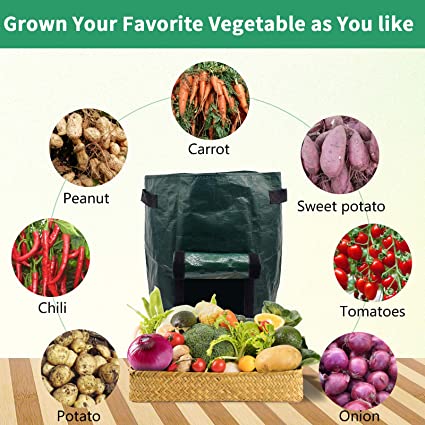Container Gardening for Survival Food Sustainability
Food shortages, high cost of living and self reliance are top reasons container gardening for survival food sustainability is necessary. You can start a garden regardless of where you live, even if you have a small space! Above Containers on Amazon
Small or Large Space Gardening
Unlike outdoor gardens, container gardening allows you to utilize small spaces. And they give you better control over temperature, growing season, and what you need to grow in order to survive.
You can start a garden using seeds or plants. And they are ideal for anyone with limited space. This means anyone can start contributing to their survival food sustainability plan. Plenty of people create container gardens on their porches.
Container Gardens are Easier to Grow
Outdoor gardens can be a struggle. There are lots of factors to consider such as the acidity of the soil, getting the right balance of nutrients. Not to mention pests and animals such as rabbits and deer.
But container gardens are easier to grow for sustainable food since you can get a ready mix soil mix that’s already blended to use.
In addition you can ensure that your plants get the exact amount of sun and moisture, nor will you need to combat unwanted weeds.
Grow for Food Sustainability and to Trade
You can grow as much food as space allows. Learn to freeze and get creative on how to use plant, vegetables, herbs and edible flowers.
You can have single containers or more than one. And set them up in one area of your home or scatter them throughout your house.
You can grow them on your front or back porch or a balcony. You can situate the containers if they’re small enough on window sills. These containers can sit in spots where the sun pours in from a door or a window.
What to Grow in Containers Gardens
There is lots of food you can grow in containers – things like vegetables, herbs and edible flowers.You can also grow fruits in small or large containers. Grow just enough for what you want – or some to share.
Mini Indoor Greenhouses

 Mini Indoor Greenhouse on Amazon <<
Mini Indoor Greenhouse on Amazon <<
If you want to, you can even create a mini indoor greenhouse. You’ll discover that not all of your plants can grow under the same conditions so you’ll have to customize soil, watering and light needed.
With container gardening, that’s an easy remedy. You can put plants with similar needs together and not have to worry about accidentally damaging the plants beside them like in a traditional gardening. When you create your garden, you can sort the items by the needs of the plants.
Save Money by Container Gardening
There are a lot of tools that you have to buy as well as the cost of plants for filling a bigger plot than you would with container gardening.
You don’t have to use a whole lot of water when you do container gardening. When you water a container, the water gets to the root system, where it needs to go. You won’t have to worry about the water sloughing off or that it’s going to evaporate – which is what happens frequently in traditional gardening.
The amount of water that you’ll need is minimal when compared to traditional gardening. Plus, you can set it up so that your container garden is self-watering. You’ll have to be careful that you don’t overwater a plant if you water it yourself.
If the roots of the plant are continually saturated, it will eventually kill it. One thing that a lot of people love about container gardening, besides how easy it is, is that you can use whatever container is healthy for the plant.
Repurpose Containers for Survival Gardens
When you are container gardening for survival you’ll need to plan and use all of the space available. Make use of free containers; such as pop bottles, flower pots and old flower pots that will now grow food instead. This is a time to get creative and use anything that will hold soil to grow edible plants and herbs.
Gather all types of items that are large enough to be divided and serve as multi-purpose planters. You can use tool boxes or wheelbarrows. Tin tubs also make great planters.
In addition gather and use ceramic pots or plastic pots. The only thing that you must be careful with is to make sure that whatever container you use has a way for water to escape as well as for the roots to get air.
Consider Your Physical Needs When Planning a Container Garden
Gardens take a lot of care. So when you begin to plan for your food sustainable garden take into consideration your physical needs. But it also requires a great deal of physical stamina. It’s not just toiling under the sun that can be difficult for some people. It’s not even that you’ll have to make sure you keep an eye out for weather that’s too cold for your plants to survive.
You’ll also need to kneel to get to weeds as well as to get low enough to inspect for pests. You may have to hold that position while you pull out the weeds or remove any pests that you find.
It might be difficult for you to do all that bending and stooping. After just ten or fifteen minutes, you’ll feel the ache in your lower back. With a container garden, you can set it up so that it’s not only convenient for you to get to, but so that it’s better for you physically.
If you have trouble bending over, then you can arrange your containers so that they’re at waist level. That way, taking care of your garden is a breeze. No more back breaking stretching and trying to care for plants.
When your garden reaches maturity, it’s a lot easier if you you arranged your containers so that they’re at best height and angle for your physical needs. All you have to do is remove the food items.
Plan According to Your Food Needs
Once you’ve put plants into the soil in a traditional garden, if you change your mind about how they’re arranged, or there’s a problem with how they’re grouped, pulling up the plants can be a major undertaking.
It can be physically and mentally draining. Sometimes, you won’t even realize that the garden isn’t working until a few days or weeks have passed. By that time, uprooting and rearranging the plants might kill the less hardy ones.
When you have a container garden, if something just isn’t working for you, you don’t have to do any major rearranging. You can just relocate the containers that the plants are in or get a different container in place of the one that you feel isn’t working for you.
You can even create a themed container garden using things like fairies or gnomes. If you’d like to create a themed container garden but need some inspiration, you can always check out Pinterest gardening pins.
Because your garden will be in containers, you can create them to be year round or you can switch them up to match special events such as having Easter lilies on a more prominent display or showcasing your holiday or hobby plants.
These would be plants such as a Christmas cactus. If you’re new to container gardening, you’re going to want to get plants that are known for their durability, because you may have a bit of a learning curve to get through in order to successfully grow the plants.
Container Gardening Success Tips
Before you design your container garden layout, you need to decide which plants you want to buy. Then plan how to group the plants so that each group them according to sunlight needs.
Germinating Trays on Amazon <<
You can put these in individual containers or together in one. Some people use stacked containers so that while the plants are grouped together, they’re not actually in the same pot.
A good rule of thumb to remember is that if the plant produces something edible that’s not leafy, it’ll more than likely need more sun than some plants. If you can’t get all your sunlight-needing plants into place in the sunlight that you have to work with, then you’ll need to consider an alternative source of light so that the plant can grow healthy.
Know ahead of time how much access to water your plant needs. Depending on the variety that you choose, some plants may need very little to survive. If you give too much water to a plant that barely uses any, you’ll at best damage the plant or create an atmosphere for fungi to grow. At worst, the plant will wilt and then die.
It’s best to hide the watering instructions within the container somewhere out of sight so that you can check if you forget. But the best way to test whether or not the plants need to be watering is to push your finger below the top layer of soil.
Many beginning gardeners make the mistake of just checking the top layer and if it feels dry, they water the plant. However, just because the top layer of soil is dry doesn’t mean the lower levels are.
Water on the top soil evaporates faster than water that’s deeper into the soil. One sign that a plant isn’t getting the correct amount of water is a change in the color of the leaves.
If the leaves on the plants start to turn yellow, check for both over or under watering. You’ll also need to check the soil every now and then. If the soil isn’t aerated enough, it becomes compact.
When that happens, your plants don’t get the correct amount of air. You can easily aerate the soil by poking something into it such as a fork or use the tines on a gardening fork.
Container Gardening Tips
Once you established your container garden you’ll want to maintain it. After all its will be part of your food sustainability plan for survival.
Tips to Maintain and Grow a Survival Container Garden:
- Temperatures that are too hot or cold is one of the biggest mistakes that people make.
- Type of container – .If your containers are plastic and the temperatures are high outside, the roots of your plant will be exposed to higher due to plastic. Move the containers or sit them on a wet surface if you move them outside.
- Deadhead aka remove dead blooms in order for the plant to grow and flourish.
- Choose the right soil for the plants is important. One kind of soil does not it will work for all the kinds of plants. Pick the right soil for indoor and outdoor gardens.
- Repot plants to expand your survival food – If you can see roots at the bottom of the pot it’s time to repot. Another sign that you may notice is that when you water the plant, the water runs right out.
Concluding Container Gardening for Survival Food Sustainability
Container gardening is one way to begin the path to food sustainability. Like this article then read more about small space gardening.






